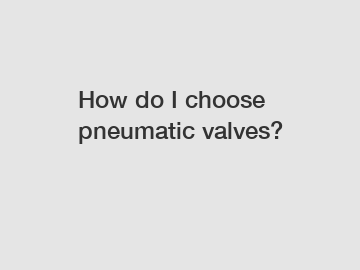How do I choose pneumatic valves?
How do I choose pneumatic valves?
Pneumatic valves play a crucial role in controlling the flow of air or gas in various industrial applications. They are essential components in pneumatic systems, ensuring the smooth operation of machinery and equipment. With a wide range of pneumatic valves available on the market, choosing the right one for your specific needs can be a daunting task. This article will provide you with a step-by-step guide on how to choose pneumatic valves to optimize your system's performance and efficiency.
Identify your application requirements.

The first step in choosing pneumatic valves is to identify your application requirements. Consider factors such as the type of media (air or gas), flow rate, pressure range, and temperature conditions. It is crucial to accurately determine the operational parameters to ensure that the chosen valve can handle the specific demands of your application.
Different types of pneumatic valves.
There are various types of pneumatic valves available, each designed for specific purposes. Here are the most common types:
1. Solenoid valves:
Solenoid valves are electromechanical devices that use a solenoid coil to control the flow of air or gas. They are popular due to their fast response time and ability to be electronically controlled.
2. Control valves:
Control valves are used to regulate the flow, pressure, and direction of air or gas in a pneumatic system. They provide precise control over the system parameters and are often used in complex applications.
3. Check valves:
Check valves, also known as one-way valves, allow fluid to flow in one direction while preventing backflow. They are commonly used to maintain pressure and prevent system damage.
Consider valve size and port configuration.
The size and port configuration of the valve should match your system's requirements. Valve size is typically specified by the nominal diameter of the valve's inlet and outlet ports. Ensure that the valve's flow capacity can handle the required flow rate of your system. Additionally, consider the port configuration, such as the number of ports and their orientation, to ensure compatibility with your system's layout.
Operating principles and actuation methods.
Understanding the operating principles and actuation methods of pneumatic valves is crucial in selecting the right one for your application. Some valves are operated manually, while others are automated using pneumatic or electric actuators. Consider factors such as the response time, reliability, and energy efficiency of the actuation method to suit your needs.
Quality and reliability.
Choosing pneumatic valves from reputable manufacturers is essential to ensure quality and reliability. Look for valves that comply with industry standards and have a proven track record of performance. Investing in high-quality valves can prevent system downtime and costly repairs in the long run.
Conclusion.
In summary, choosing the right pneumatic valves for your application requires careful consideration of various factors such as application requirements, valve types, size and port configuration, operating principles, and actuation methods. By understanding these factors and consulting with experts, you can select the most suitable valve that will optimize the performance and efficiency of your pneumatic system.
For further assistance or to explore our range of pneumatic valves, please do not hesitate to contact us.
Want more information on China ball vs butterfly valve factory, China ball valve pneumatic actuator factory, bellows gate valve? Feel free to contact us.
205
0
0

Comments
All Comments (0)